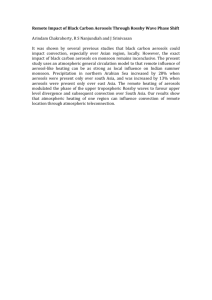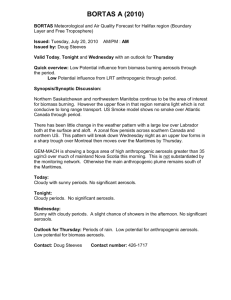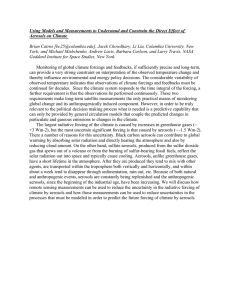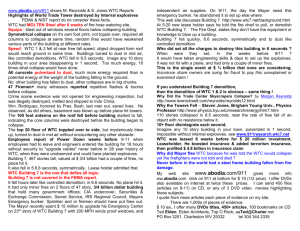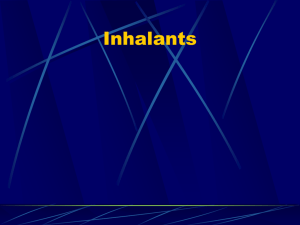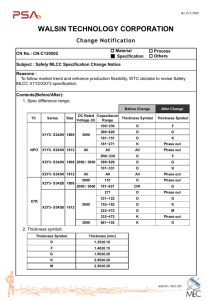http://delta.ucdavis.edu/WTC%20aersols%20ACS%202003.ppt
advertisement
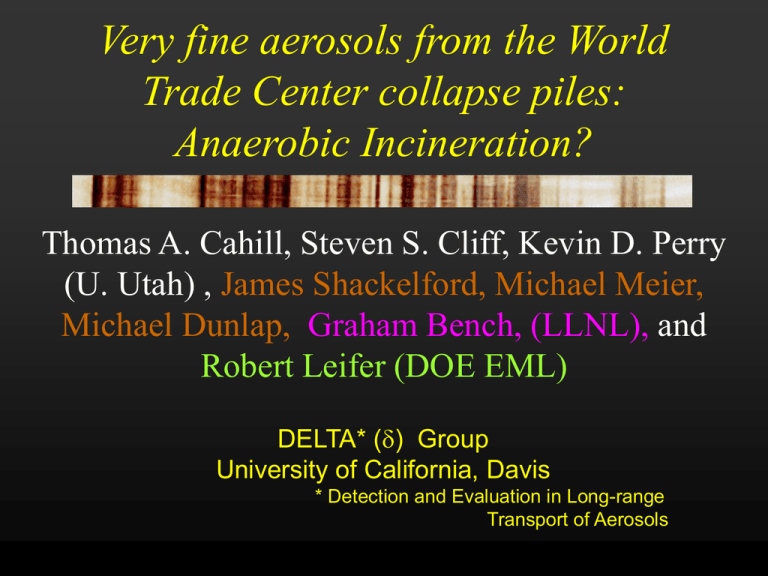
Very fine aerosols from the World Trade Center collapse piles: Anaerobic Incineration? Thomas A. Cahill, Steven S. Cliff, Kevin D. Perry (U. Utah) , James Shackelford, Michael Meier, Michael Dunlap, Graham Bench, (LLNL), and Robert Leifer (DOE EML) DELTA* () Group University of California, Davis * Detection and Evaluation in Long-range Transport of Aerosols Background The collapse of the World Trade Center structures (South Tower, North Tower, and WTC 7) presented two very different types of air pollution events: 1. Initial fires and collapse-derived “dust storm” 2. Continuing emissions from the debris piles Both cases shared the unusual aspect of a massive ground level source of particulate matter in a highly populated area with potential health impacts. New data to explain aerosols from the WTC collapse piles • Association of metals with prior data on municipal incinerators, especially those with chlorine-rich waste • Correlation between coarse, metal coated aerosols with very fine aerosols • New time and compositionally resolved data on fine and very fine aerosols • Indoor very fine aerosols near WTC, May, 2002 • Outdoor very fine Eastern urban aerosols, August, 2002 In addition…. • Indoor aerosol data for Sept, 11, 2001 for 8 hr in a near-WTC office Location of DELTA/DOE sampling site 1.8 km NNE WTC, Oct. 2 – Dec 20 DELTA Group slotted 8 DRUM Impactor • 8 size ranges: 43 cm • • • • • • • • Inlet ( ~ 12) to 5.0 μm 5.0 to 2.5 μm 2.5 to 1.15 μm 1.15 to 0.75 μm 0.75 to 0.56 μm 0.56 to 0.34 μm 0.34 to 0.26 μm 0.26 to 0.09 μm • 10.4 l/min, critical orifice control, ¼ hp pump • 6.5 x 168 mm Mylar strips • For 42 day run, 4 mm/day, time resolution = 1 hr. • Field portable • 10 kg, 43 × 22 × 13 cm Aerosol DRUM Strips from WTC Oct. Rain 3 event Ocean winds Oct.2 to Oct. 30, 2001 ~12 to 5 μm 5 to 2.5 μm 2.5 to 1.15 μm 1.15 to 0.75 μm 0.75 to 0.56 μm 0.56 to 0.34 μm 0.34 to 0.26 μm 0.26 to 0.09 μm DELTA Group Analytical Techniques Beam based, 100-500 μm, non-destructive • Soft beta ray mass ( mass) • 320-820 nm optical attenuation, 10 nm steps • Synchrotron X-ray fluorescence, polarized “white” beam 4 keV to 18 keV (S-XRF) – ALS LBNL • Scanning Transmission Ion microscopy (STIM) – CAMS LLNL • Proton Elastic Scattering Analysis (PESA) - LLNL • Laser Desorption Ionization Time-of-Flight Mass Spectrometry (LDITOF/MS) • Scanning Electron Microscopy (SEM) Under what conditions and with what efficiency can the WTC plume impact the sampling site, 1.8 km NNE of the WTC and 50 m above ground level? Wind direction: HYSPLIT trajectory wind from 202o + 60o (incl. dispersion) Weighting by cosine Plume lofting: Surface temperature of the WTC collapse site Vertical atmospheric stability: HYSPLIT isentropic trajectories subsiding and/or high vertical dispersion Concentrations are modulated by: Emission rates from the collapse piles Vertical and horizontal dispersion rates Wind speed - “Residence Time” 1/u (200m) weighting Rainfall and fogs - Estimates of wet and dry removal rates Manhattenville P.O. PS 154 9/12 75 3pm 9/11 9am 9/13 11 pm 50 Afternoon/ Evening 25 0 75 9/12 9pm 50 9/13 7pm 9/11 9am PS74 25 Micrograms/m3 PM2.5 Micrograms/m3 PM2.5 Microgram/m3 PM2.5 100 100 0 100 75 100 80 9/13 4pm 60 9/11 9am 40 20 0 9/13 9am 9/11 9am 9/12 1pm PS199 50 Microgram/m3 PM2.5 Micrograms/m3 PM2.5 PS64 25 0 WTC 75 9/13 8pm 50 25 0 PS274 Micrograms/m3 PM2.5 100 9/11 9am 100 9/13 9am 75 9/11 9am 50 25 0 Maspeth Library Fish Kill Met Microgram/m3 PM2.5 Micrograms/m3 PM2.5 PM2.5 Measurements in NYC - Week of Sept 10 2001 100 75 9/11 9am 50 25 0 9/13 7am 9/13 midnight 100 9/13 noon 75 9/11 9am 50 25 0 Max 247 PM10, Coarse and Fine Aerosols in New York City 156 PM2.5 1 hr DRUM samples, LLNL STIM analysis, UC Davis DELTA Group Micrograms/m3 100 80 Rain Event 60 Rain Event 40 20 0 2 3 3 4 4 5 5 6 6 7 7 8 8 9 9 10 11 12 13 14 15 16 17 18 19 20 21 22 23 24 25 26 27 28 29 30 10 11 12 13 14 15 16 17 18 19 20 21 22 23 24 25 26 27 28 29 30 31 WTC met impact Note: PM10 is roughly PM12, no ultra-fines; on 10/18,19: 10/26-30 PM10 = PM5.0 PM2.5 contains no ultra fines < 0.1 micons October, 2001 PM10 Mass PM2.5 Mass EPA Analysis of PM10 Mass 24 hour data October 3 Rain Event Rain Event Note plume subsidence Relative Abundance Anomalous Size Distribution of Aerosols from the WTC, October 3 Typical mineral matter WTC sulfate Typical sulfate WTC mineral matter 12 to 5 5 to 2.5 2.5 to 1.15 1.15 to 0.75 0.75 to 0.56 0.56 to 0.34 Size Fraction (micrometers) 0.34 to 0.24 0.24 to 0.09 Why do we care about very fine (0.26 > Dp > 0.09 μm) aerosols? EPA (AAAR, 10/2002) summarized 5 causal factors most likely to explain the statistically solid data connecting fine PM2.5 aerosols and human health. Biological aerosols (bacteria, molds, viruses…) acidic aerosols very fine/ultra fine ( < 0.1 μm) insoluble aerosols fine transition metals high temperature organics 4 of the 5 reached unprecedented ambient levels in the very fine aerosol plumes from the WTC collapse piles On most days, the plumes lofted above NYC so that only those on or near the WTC site breathed these aerosols. Why was the debris pile so hot, so long? Energy (est.) Kinetic energy of falling building Chemical energy of cars in garage Chemical energy of diesel/Con Ed oil (in units of 10 11 joules) 5 (+2.5oC) 10 150 • Especially under WTC #7 Chemical energy of building combustibles 430 • Perhaps 15% burned before the buildings collapsed The surface and near sub-surface debris pile was hot enough to melt aluminum, make steel red hot, and burned until Dec. 19. But this is still much cooler than typical sources of very fine particle metals such as power plants, smelters, and diesels. Very fine mass by STIM and estimated New York Very Finematter Aerosolsfrom Post Sept. 11, 2001 total organic PESA Mass and T o tal Org anic Matte r (0.26 > Dp > 0.09 micro me te rs) 10 Mass by STIM 9 Organics by PESA Micrograms/m3 8 7 6 5 4 3 2 1 0 2 3 4 5 6 7 8 Organics derived from nonvolatile hydrogen, assuming sulfur in the form of sulfuric acid 9 10 11 12 13 14 15 16 17 18 19 October, 2001 20 21 22 23 24 25 26 27 28 29 Very fine aerosol plumes at Varick Street 18 events with very fine (0.26 > Dp > 0.09 μm) aerosol mass > 3.0 μg/m3, > 10 x background, in 3 to 6 hr plumes Criteria # events HYSPLIT wind in SSW quadrant 14 + 1 calm Very fine organics > 1.0 μg/m3, 16 2.5 to 5 μm cement dust EF > 2.5 16 2.5 to 5 μm sulfate > 0.3 μg/m3 15 Simultaneous ground based 3 hr hazes plumes at LaGuardia airport, Lv < 15 km 5 (+ 3 days Sept.) 5 events met all 5 criteria, 4 more met 4 of the 5 criteria – these 9 are labeled “highly probable events”; 6 met 3 of the 5 criteria – labeled “WTC influence” a total of 15 events over 20 days, 1 met only 2 of the criteria - uncertain source 2 met one of the criteria, but not SSW quadrant – labeled “non-WTC plumes none of the criteria – labeled “background days” - a total of 6 days Concentration of Very Fine Aerosols 3 hr peak averages, Micrograms/m3 (ng/m3 - V, Ni) Date WTC impact Mass Org. SiO2 H2SO4 V Ni Oct. 7 No 0.5 0.04 0.02 0.1 0.1 0.1 Oct. 3 Yes 50.6 9.3 1.4 17.1 115 22.7 Oct. 4 Yes 9.3 3.2 2.6 3.7 61 8.0 Oct. 5 Yes 4.7 1.5 0.9 1.9 3 1.3 Oct.12 Yes 8.2 3.0 2.9 2.2 24 7.1 Oct.15 Yes 4.8 1.6 1.3 1.1 3 17.3 Oct.24 Yes 3.8 1.0 0.2 1.6 5 6.7 Oct.29 No 2.4 1.2 0.07 0.9 2 1.6 Kuwait - na na 0.6 5.5 na 5.0 Beijing - na na 1.1 6.7 0.8 1.8 Comparison of October, 2001 to May, 2002 Very fine particles 0.26 > Dp > 0.09 microns Ratio to WTC Impact days (20) Oct., 2001 WT C impact days 20 Oct, 2001 Non-WT C plumes 4 Oct., 2001 "clean" days 6 181 ng/m 3 467 ng/m 3 10 ng/m 3 39 ng/m 3 May, 2002 near WT C May, 2002 midtown 3.9 ng/m 3 3.8 ng/m 3 0.9 ng/m 3 1 0.8 0.6 0.4 0.2 0 Si S V Fe Elements Ni Cu Se New York Coarse Aerosols post Sept. 11, 2001 U C D a vis D R U M D a ta from 201 V a rick S tre e t 5.0 > D p > 2.5 microme te rs Ocean Wind 800 700 Nanograms/m3 600 Rain Event Rain Event 500 400 300 200 100 0 30.21 0.00 6.51 2 4 3 6 5 8 7 10 9 12 11 WTC met impact P hosphorus 14 13 16 15 18 17 20 19 22 21 24 23 26 25 28 27 Octobe r, 2001 S ulfur Chlorine P ota ssium 30 29 31 New York Coarse Aerosols post Sept. 11, 2001 UC Davis DRUM Data from 201 Varick Street 5.0 > Dp > 2.5 micrometers “Crustal” elements 3 Thousands Nanograms/m3 2.5 Rain Event 2 Rain Event 1.5 1 0.5 0 30.21 6.51 0.00 2 4 3 6 5 8 7 10 9 12 11 WTC met impact 14 13 16 15 18 17 20 19 22 21 24 23 26 25 October, 2001 Silicon Calcium Iron Aluminum 28 27 30 29 31 New York very fine Aerosols post Sept. 11, 200 UC Davis DRUM Data from 1.8 km NNE 0.26 > Dp > 0.09 micrometers Micrograms/m3 Thousands 1.5 Ocean Wind 1 Rain Event Rain Event 0.5 0 30.21 0.00 6.51 2 4 3 6 5 8 7 10 12 14 16 18 20 22 24 26 28 30 9 11 13 15 17 19 21 23 25 27 29 31 WTC met impact Silicon October, 2001 Calcium Iron Aluminum Proposed explanation of very fine aerosols size and composition • Problems: • We see very fine aerosols typical of combustion temperatures far higher than the WTC collapse piles • We see some elements abundantly and others hardly at all, despite similar abundances in the collapse dust • We see organic species in the very fine mode that would not survive high temperatures • Explanation • The hot collapse piles are converting some species to gasses that can escape to the surface of the piles and then form aerosols, a process that yields very fine particles Incineration Boiling Earth Bulk dust Bulk dust Volatility Principal with 10% chlorine Point crustal EPA Lioy Temp Species o o Metal C ppm ppm ppm C Chromium 2639 102 71.5 165 1594 CrO2 ,O3 Beryllium 1280 2.8 1.75 3.2 1042 Be(OH)2 Barium 1634 425 195 381 895 BaCl2 Nickel 2834 84 15.5 43.5 686 NiCl2 Antimony 697 0.2 na na 653 Sb2O3 Silver 2190 0.004 4.9 2.3 620 AgCl Selenium 0.05 < 0.96 na 315 SeO2 Cadmium 761 0.15 3.8 7.2 211 Cd Vanadium 3480 120 18.3 38.9 147 VCl4 Thallium 1464 9.6 <0.96 1.4 136 TlOH Osmium 4224 0.0015 na na 40 OsO4 Arsenic 814 1.8 < 0.96 2.6 32 As2O3 Mercury 353 0.085 0.37 nd 25 Hg SiO2 1725 9000 na na 12 SiCl4 Lead 1748 14 98 305 -12 PbCl4 Predicted metal emissions from the WTC collapse piles • Assumption: The molecular compounds will oxidize when these gasses reach the hot surface, which was capable of spontaneous surface fires until mid-December. • There will then be fine metal aerosols, probably as oxides, richest in those elements with both high abundance and chlorine-depressed volatility temperatures – • Silicon, vanadium, nickel, lead • There will then be an absence of fine metal aerosols with high volatility temperatures, even if their abundance is high – • Chromium, barium Very fine mode aerosols in WTC plume and non-plume conditions Very fine aerosols October 7 October 3 background WTC plume Average Abundance Volatility Temperature 0.26 - 0.09 m g/m3 g/m3 WTC dust 10% chlorine Mass Organics Sulfur 0.53 0.04 0.04 ng/m3 11 0.1 <0.5 0.1 <0.1 < 0.1 50.7 9.3 5.6 ng/m3 698 114 26 23 1.5 < 0.5 na na na ppm abundant 30 200 30 120 290 na na na o C 12 147 -12 686 1594 895 Silicon Vanadium Lead Nickel Chromium Barium Very fine aerosols 0.26 . Dp > 0.09 micrometers 80 Nanograms/m3 70 60 50 40 30 20 10 0 V 30.21 2 4 3 6 5 8 7 10 9 12 11 14 13 16 15 18 17 20 19 22 21 October, 2001 Vanadium Chlorine 24 23 26 25 28 27 30 29 31 New York Aerosols post Sept. 11, 2001 UC Davis DRUM Data from 201 Varick Street Anthropogenic elements 20 Ocean Wind Nanograms/m3 15 Rain Event Rain Event 10 5 0 V 30.21 6.51 2 4 3 6 5 8 7 10 9 12 11 14 13 16 15 18 17 20 19 22 21 24 23 October, 2001 WTC met impact Vanadium Chromium Nickel 26 25 28 27 30 29 31 Lead in lower Manhattan near WTC EPA 12 hr lead values 5 Micrograms/m3 4 3 2 Rain 1 Rain 0 UCD 11 15 13 19 17 23 21 27 25 1 29 September 5 3 9 7 - North site, south wind 13 11 17 15 21 19 25 23 October, 2001 South sites, north wind 29 27 31 Conclusions – WTC Aerosols • • • • (additions since September, 2002 in blue) There were heavy and continuing emissions of aerosols in narrow plumes of unusual size and composition from the WTC collapse site that on 9 to 15 occasions impacted 201 Varick St, 1.8 km NNE. Coarse particles were similar to the initial collapse aerosols (cement, dry wall, glass, ...) but had chemicals and soot from the ongoing combustion. Little asbestos was expected or observed. The presence of unprecedented (vis. Beijing, Kuwait) levels of very fine (0.26 > Dp > 0.09 μm) particles by mass and number in narrow plumes was more typical of an industrial source, specifically a chlorine rich municipal incinerator, than any normal ambient air situation. Upwind sources were a very minor contribution. The very fine silicon and sulfur and many of the coarse metals like vanadium decreased steadily during October. Very fine particles near the WTC site in May, 2002, were generally < 10% of the October, 2001 plume impact days at Varick Street. (except S, Ni) For more details…….. Lioy et al, Environmental Health Perspectives 110, #7 703-714 July, 2002 (3 bulk samples collected dry, 9/16, 9/17, exhaustive analyses) Cahill et al (in press, Aerosol Science & Technology (2003) EPA web site www.epa.gov/ response to 9/11, EPA ORD analysis and Power Point presentation NASA EOS Landsat Thematic Mapper , IKONOS satellite photos from Spaceimaging.com, DELTA web site http://delta.ucdavis.edu, WTC data and the Fall, 2002 ACS Powerpoint presentation. Acknowledgements • We wish to thank all the people and groups that contributed time and resources for this unfunded project, especially LLNL (STIM/PESA grant) , ALS LBNL (S-XRF beam time), UCD DELTA Group staff, and DOE EML NYC. • The authors gratefully acknowledge the NOAA Air Resources Laboratory (ARL) for the provision of the HYSPLIT transport and dispersion model (http://www.arl.noaa.gov/ready.html) and the READY web site used in this publication. • We gratefully acknowledge the support of the American Lung Association for the May, 2002 study, and Prof. John Ondov for urban data examples. • We wish to thank all the people who helped increase our understanding of the WTC problem, and in particular the very helpful analysis of Prof. Ian Kennedy (UCD Engineering) and Dr. William Wilson, (ORD, US EPA. • Finally, we want to thank the organizers of this symposium and the support they provided for this program. Other Aerosol Sources – October, 2001 Regional Aerosols > 100 km Sulfates, organic matter New York/New Jersey Metropolitan 15 – 100 km Natural oceanic aerosols Heavy fuel oil • Power plants (all reportedly using natural gas) • Ships Other sources Local < 15 km Diesel generators and trucks, smoking cars New York industrial sources Elemental Analysis of Size Resolved Diesel Particles C-12 Sample #4, CA fuel , Dilution :1 S -XR F Ana lysis, U C D a vis; on Myla r, no gre a se Micrograms/m3 1.4 1.2 1 0.8 0.6 0.4 0.2 0 1 2 3 Coarse 4 PM2.5 Mass/200 5 6 7 8 MOUDI Stage Phosphorus 9 10 11 12 13 Very Fine Ultra Fine Sulfur Zinc x 10 14 y fine (0.26 > Dp > 0.09 micron) aerosols at an eastern US city. Typical source signatures, Summer, 2002 Zinc Potassium / 10 Vanadium Nickel Oil fired power plant Incinerator 7 8 9 10 11 August, 2002 12 13 14 Aerosol DRUM Strips – coarse to very fine New York City, Oct 2 to 30, 2001 Beijing, P.R. China March 20 to April 26, 2001 Coarse ~12 to 5 μm 5 to 2.5 μm 2.5 to 1.15 μm 1.15 to 0.75 μm 0.75 to 0.56 μm 0.56 to 0.34 μm 0.34 to 0.26 μm Very fine 0.26 to 0.09 μm DELTA Group Synchrotron-XRF Facility at the LBNL Advanced Light Source For scale? (At least it’s not duct tape.) Typical S-XRF Spectrum 0 4 8 Energy (keV) 12 16 IMPROVE S-XRF 1 RTI XRF 10 Na Si S V Ni As Sr Cd Ba Pb Strontium 100 Bromine Rubidium 1000 Arsenic and Lead Fluorine Counts 10,000 Vanadium Manganese Iron Nickel Copper Zinc 100,000 Sulfur Potassium Calcium Raw data, Teflon substrate with no blank subtraction 150 6 4 1 0.9 1.7 2.3 7.6 84 4 100 23 20 6 0.9 0.5 1.3 NA NA 2 14 3 3 0.1 0.2 0.1 0.3 NA 1.0 0.6 MDL values (ng/cm2) Analysis of coarse aerosols Dp > 2.5μm Large amounts of coarse aerosol mass was seen during the October 3 3 hr plume (220 μg/m3) and smaller amounts later in the month Composition was crustal with enhanced calcium (vis cement dust) during times of WTC transport, with pH from 11.0 to 12.1 (USGS, 9/2001) Particles were visibly coated with soot Numerous non-crustal elements had high enrichment factors showing anthropogenic sources Many of these non-crustal elements decreased later in October But one can argue against this hypothesis • No convincing local meteorology – street canyon effects, etc, • Not similar to dust from the immediate collapse (Lioy et al, 2002) • No prior size/time/compositionally resolved data from NYC for comparison purposes • No data on emission factors at source • Strange elemental ratios with no clear sources Were the aerosols observed at Varick Street from the WTC collapse piles? • High levels of very fine < 0.26 µm mass, H, and S in short duration ( circa 3 hr) plumes • Short atmospheric lifetimes, therefore local • Peaks seen on winds from the Southwest • Subsiding isentropic trajectories, so ground impact • Relatively fine 5.0 to 2.5 μm cement dust with anomalous elements (sulfur, metals,,,) • On 5 occasions, simultaneous haze plumes at La Guardia Proposed Answers Indoor fine particles? Either the very fine particles (such as silica) never penetrated the three buildings we tested (most probable) or they were effectively cleaned up (possible). October 3, 4, and 5? These days were high because unusual meteorology (plus a cooling WTC debris pile) drove the plume down to 50 m (and below). Under what conditions and with what efficiency can the WTC plume impact the sampling site, 1.8 km NNE of the WTC and 50 m above ground level? Wind direction: HYSPLIT trajectory wind from SW Plume lofting: Surface temperature of the WTC collapse site Wind speed: “Residence Time” 1/u (200m) weighting Vertical atmospheric stability: HYSPLIT isentropic trajectories subsiding Removal - settling, diffusion, rainfall and fogs: Estimates of wet and dry removal rates Outstanding Questions -WTC Aerosols • • • • What are the health impacts of these aerosols? Do the very fine particles linger indoors? Why was October 3 so impacted? What is the source of the S/V/Ni “fuel oil” combustion signature? • What is the morphology of the metal and sootcoated coarse particles? • What are the sources and impacts of the organic matter? 600 4 October 2002, WTC Plume, 201 Varick Street, NYC 0.09-0.24 m Particles, Positive Ions 500 K+ 400 I n t e n 300 s i t y 200 PAH plastic Na+ 147 203/205 219/220/221 252 100 0 0 50 100 150 200 Mass/Charge WTC8P315.DAT 250 300 4 Very fine Particles 0.26 to 0.09 μm, Oct. 3 October 3 Sites Sampling Sources/ Sinks Fresh Kills S.I. Distance to WTC site (km) PM2.5 Mass (24 hr) (g/m3) - 21. 22.3 (EPA) - 17. 27.6 (EPA) PM2.5 Mass DRUM – time resolved, (g/m3) 842 MW PP S.I., (gas) PS 44 Staten Is. Battery Park - 0.9 WTC Site plus diesels MBCC 30.6 (EPA) 0.0 NNW + 0.7 37.8 (EPA) DOE EML NNE + 1.8 48.2 (DRUM) (site at 50 m) 135 in 3 hr plume 25.3 12 hr non- plume PS 64 NE + 2.7 36.0 (EPA) Coarse particles ~ 12 to 5 μm, Oct. 3 New York Very Fine Aerosols post Sept. 11, 2001 U C D a vis D R U M D a ta fro m 1.8 km N N E 0.26 > D p > 0.09 micro me te rs Nanograms/m3 1500 1000 500 0 30.21 2 4 3 6 5 8 7 10 9 12 11 14 13 16 15 18 17 20 19 22 21 24 23 26 25 28 27 30 29 31 October, 2001 S ilico n S ulfur 80 Nanograms/m3 70 60 50 40 30 20 10 0 6 .5 1 V 30.21 2 4 3 6 5 8 7 10 9 12 11 14 13 16 15 18 17 20 19 22 21 24 23 26 25 October, 2001 WTC met impact V a na d ium Chro mium N icke l 28 27 30 29 31 Incineration with 10% chlorine Boiling Point Earth crustal Bulk dust EPA 2003 Bulk dust Lioy 2002 Volatility Temp Metal oC ppm ppm ppm oC Chromium 2639 102 71.5 165 1594 CrO2 ,O3 Beryllium 1280 2.8 1.75 3.2 1042 Be(OH)2 Barium 1634 425 195 381 895 BaCl2 Antimony 697 0.2 na na 653 Sb2O3 0.05 < 0.96 na 315 SeO2 Selenium Principal Species Cadmium 761 0.15 3.8 7.2 211 Cd Osmium 4224 0.0015 na na 40 OsO4 Arsenic 814 1.8 < 0.96 2.6 32 As2O3 Mercury 353 0.085 0.37 nd 25 Hg Vanadium 3480 120 18.3 38.9 147 VCl4 Nickel 2834 84 15.5 43.5 686 NiCl2 Silver 2190 0.004 4.9 2.3 620 AgCl Thallium 1464 9.6 <0.96 1.4 136 TlOH Lead 1748 14 98 305 -12 PbCl4 SiO2 1725 280,000 na na 12 SiCl4

